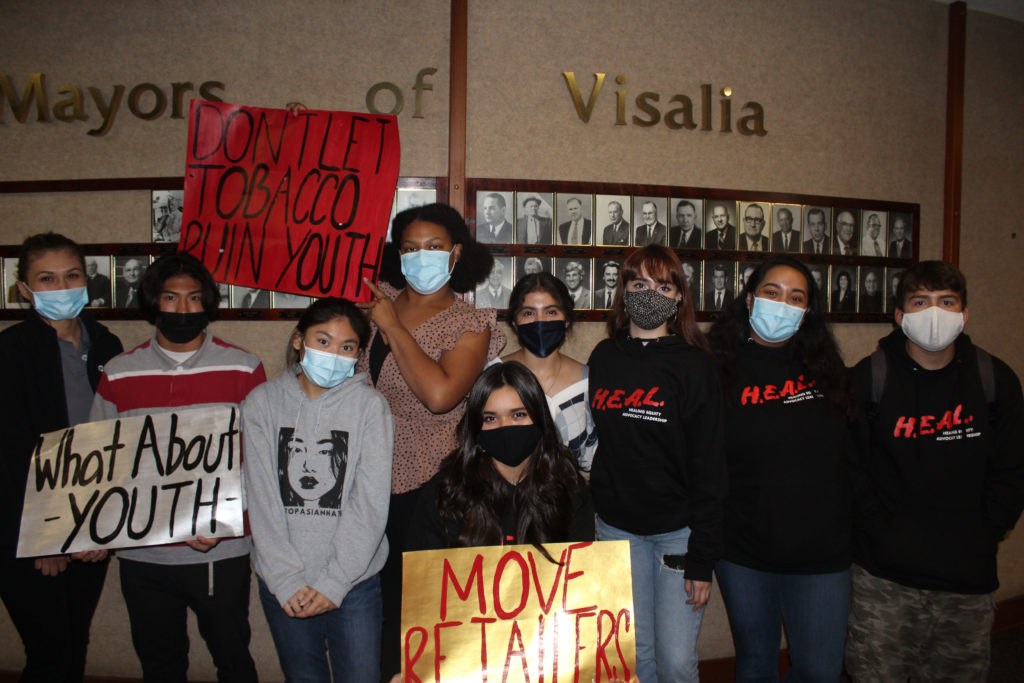Administrative aspect by: Nick Schonken
Student aspect by: Ryan Kaspar
Administration and Prevention of Student Smoking
School districts across the nation and counties deal with a unifying cause, teenagers who smoke. Whether cigarettes, blunts, or vapes, it is happening.
If you were recently a student in the Visalia Unified School District, you may remember your middle school P.E. class being taught about the troubles of drugs in a program similar to D.A.R.E. But similarly to D.A.R.E., programs such as these often prove highly ineffective.
Leading to drug use that follows students through their education.
This is where administrative school staff comes into play. In Redwood high school, staff such as Eric Rodriguez, an assistant principal in charge of student discipline, is in control of supervision and regulation of students who smoke.
One of the first steps administration on campus takes to curve student smoking is bathroom checks. Rodriguez says, “we have our campus monitors check the restrooms throughout the day” as well as admins; during breaks, “before school, [and] after school; checking to see if kids are vaping.”
Rodriguez says that if the monitors or admins find damaged bathrooms or kids smoking, they briefly close down the bathroom to discourage further issues.
He continues by saying, “if and when we find students smoking, we automatically contact their parents. We confiscate whatever is in their possession” and determine their consequence based on what they were smoking… whether it was a nicotine or THC derived device.
When it comes to nicotine-based forms of smoking/vaping, students have their form of smoking confiscated; they receive lunch detention and a call home to their parent/guardian.
Rodriquez says that “depending on the parent’s suggestions, sometimes [students] return to class [or] sometimes [students] are taken home for the day; cause [the parents] wanna do whatever they feel is necessary. Sometimes, some parents ask to take them home to do drug testing, take them to a drug counselor, or other things.” Saying, “we support the parent in whatever they wish.”
He proceeds by saying that if students are consuming “THC… or other controlled substance than there is suspension involved; and that will vary on whether its a first, second, [or] third offense,” and whether a “three-day suspension, five-day suspension, [or] a possible recommendation for expulsion…” are required.
For the most part, the YSO (Youth Service Officer) is not called in for nicotine-based confiscations, unless the individual is violent. The YSO is however called in when there is “an intent to sell.” At that point, the student’s actions are a “legal matter,” according to Rodriguez.
Intervention of Student Smoking
When it comes to student intervention, there are those who independently ask for help and those that the school mandate to receive it.

Gabriel Luna, Redwood’s psychologist, says that when it comes to students that come “independently and asks for help with [smoking], we first have a conversation about how it all started” and why “they want to stop it at this point and time.”
He says that “we first offer the student to be identified on our Tier 2/3 intervention team list, to collaborate with other on-site professionals on ways to intervene, assign someone to monitor and check-in and connect with the student, and to provide weekly updates on their progress. The hope is that the intervening time and strategies discussed will help provide encouragement and support while the student is building their strength and confidence in avoiding the prior behaviors that had become ritualistic in their reinforcement.”
According to Luna, Tier 2/3 intervention is “how a number of our on-site professionals gather for a meeting to discuss individual students that have been identified either by their teacher, parent, or school counselor in need of intervention whether it is academic, behavioral, or social-emotional (mental health).”
As a school psychologist, it is imperative that we provide a space that is free of judgement. When we meet individuals, our effort is to make them feel comfortable and safe so they can reflect on the issue and have an open discussion on what is being accessed and why.
Gabriel Luna, school phycologist
Students who reach out are suggested to access outside resources. Luna mentions programs such as Turning Point, which is a local intervention program that sends out alcohol and drug rehabilitation counselors to high schools for onsite planning and intervention.
When it comes to students who are not willing to quit or give up smoking, Luna says “there is not much that can be done to intervene other than the natural consequences of being “underage” and in possession of identified contraband as written in the student conduct code for VUSD.”
He continues with, “If a student is being given disciplinary actions due to a choice in underage smoking, it can only be up to the individual to want to avoid the consequences, so the choice would then to at least be encouraged to not smoke during the school hours. If the choice is due to “peer pressure” it is again up to the individual to decide if getting a consequence is worth the decision to smoke while on school campus. As an onsite support professional, I am always going to encourage our students to recognize the “downside” of smoking and how it can negatively impact their lives over the long term, rather than just during their high school years.”
Student’s Perspectives
While the majority of students are aware that vaping and smoking are bad for you, many students share contradicting opinions on the subject as a whole.

Jasmine Luna ’22, a member of the H.E.A.L. [Healing, Equity, Advocacy, and Leadership] Project, says she remembers, “a whole week in school during [her] Sophomore year in 2019, when smoke alarms were going off the entire week, causing innocent students to not be able to use the bathroom when they had to.”
She adds that she “just [wants] to be able to use the restroom without having to worry about getting a headache from the horrible smell of vape and weed.”
She feels that vaping “is ruining our younger generations,” with flavored vapes masking “millions of micro-metals and other harmful addictive chemicals inside.”
Luna says that “a lot of young people think it’s a great way to fit in, but then they end up falling into addiction.”
Jaki Ramirez, another member of the H.E.A.L. Project, says that “the majority of kids and even star students [that the] admin love and adore vape and smoke,” and the reason they smoke is often “because [they] don’t want to smoke weed anymore.”
Even though Ramirez “[doesn’t] care if kids vape,” she believes they should “have the right resources available to them and [should be] aware of those resources if they ever wish to quit vaping.”
When asked about the district’s handling of the issue, Ramirez says “Admin has done a horrible job in handling this situation and honestly I don’t even believe that they actually care.”
“Vaping can be rooted in so many issues that kids sometimes just need to talk about,” says Ramirez. “This is an issue with nuance.”
Ramirez is currently working with the H.E.A.L. Project to “[minimize] the sentence if you get caught vaping. Instead of being sent home for suspension, you would get resources and if it’s multiple offenses go to a counselor of some sort.”
“I feel like the vaping issue isn’t being looked at deep enough. Nicotine can be very addictive and these kids are losing school time because they aren’t given the proper resources they need.”
Jaki Ramirez, ’22
Although many students care deeply about the subject, others are more indifferent towards it.
According to an anonymous student at Redwood, vaping has become normalized. “It’s a huge stress reliever for so many teens no matter how bad it is for you,” they say.
The student continues, “Admittedly, yes, I have, and I think a lot of students have, [smoked or vaped].”
“I think we’ve all seen other people do it or been offered something in the bathroom. It’s not the peer pressure situation the schools tend to make it out to be though. You get offered something, you say no, or yes, and everyone moves on.”
Even though they aren’t “sure how admin deals with [students who smoke],” they still hope that “admin [doesn’t just view] the issue at face value, and [instead] looks farther into why the student is smoking. Not just the punishment.”
They say that it doesn’t matter much to them because “everyone [they] know is smart enough” to “not get caught with it.” They add it’s “not hard.”
“I feel like a lot of people get really upset about it; and honestly, I just don’t care that much. The only part that is annoying is when our bathrooms get shut down because of [smoking]. It just doesn’t affect me, otherwise people can do whatever they want with their lives.”
Anonymous Redwood Student
This is part two of a two-part series on student smoking. Read the first part here.
Work Cited
Photography, Possessed. “Photo by Possessed Photography on Unsplash – ‘No Smoking’.” Unsplash, 19 June 2019, https://unsplash.com/photos/iI6ASO8aACU.
D.A.R.E., https://dare.org.
West, Steven L, and Keri K O’Neal. “Project D.A.R.E. Outcome Effectiveness Revisited.” American Journal of Public Health, © American Journal of Public Health 2004, June 2004, https://www.ncbi.nlm.nih.gov/pmc/articles/PMC1448384/.
SHVET Productions. “Man Explaining Problems to Faceless Psychologist.” Pexels, https://www.pexels.com/photo/man-explaining-problems-to-faceless-psychologist-7176030/.
Ozturk, Ayla. H.E.A.L. and API PACT Members at a City Council Meeting (Image).
Tags: clubs & lifestyles, Eric Rodriguez, Gabriel Luna, Intervention, Nick Schonken, redwood high school, rhs, Ryan Kaspar, Smoking, Tier 2/3, vaping, visalia ca

